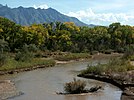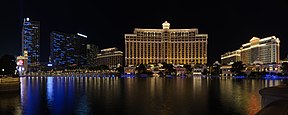
Back جنوب غرب الولايات المتحدة Arabic Югозапад (САЩ) Bulgarian Sud-oest dels Estats Units Catalan Jihozápad Spojených států amerických Czech Südwesten der Vereinigten Staaten German Sudokcidenta Usono Esperanto Suroeste de Estados Unidos Spanish ایالتهای جنوب غربی آمریکا Persian Sud-Ouest des États-Unis French Súdwesten (Feriene Steaten) Frisian
Southwestern United States | |
|---|---|
| American Southwest, the Southwest | |
Monument Valley, AZ Cathedral Rock – Sedona, AZ Route 66 in downtown Albuquerque, New Mexico Palace of the Governors in Santa Fe, NM | |
![Though regional definitions vary from source to source, Arizona and New Mexico (in dark red) are almost always considered the core, modern-day Southwest. The brighter red and striped states may or may not be considered part of this region. The brighter red states (California, Nevada, Utah, and Colorado) are also classified as part of the West by the U.S. Census Bureau, though the striped states are not; Texas and Oklahoma are classified as part of the South.[1]](http://upload.wikimedia.org/wikipedia/commons/thumb/e/ef/Southwest_map.png/250px-Southwest_map.png) Though regional definitions vary from source to source, Arizona and New Mexico (in dark red) are almost always considered the core, modern-day Southwest. The brighter red and striped states may or may not be considered part of this region. The brighter red states (California, Nevada, Utah, and Colorado) are also classified as part of the West by the U.S. Census Bureau, though the striped states are not; Texas and Oklahoma are classified as part of the South.[1] | |
| Coordinates: 37°N 111°W / 37°N 111°W | |
| Country | United States |
| States | Core: Arizona New Mexico Others, depending on boundaries used: California Colorado Nevada Utah Oklahoma Texas |
The Southwestern United States, also known as the American Southwest or simply the Southwest, is a geographic and cultural region of the United States that includes Arizona and New Mexico, along with adjacent portions of California, Colorado, Nevada, Oklahoma, Texas, and Utah. The largest cities by metropolitan area are Phoenix, Las Vegas, El Paso, Albuquerque, and Tucson.[2] Before 1848, in the historical region of Santa Fe de Nuevo México as well as parts of Alta California and Coahuila y Tejas, settlement was almost non-existent outside of Nuevo México's Pueblos and Spanish or Mexican municipalities. Much of the area had been a part of New Spain and Mexico until the United States acquired the area through the Treaty of Guadalupe Hidalgo in 1848 and the smaller Gadsden Purchase in 1854.
While the region's boundaries are not officially defined, there have been attempts to do so.[3] One such definition is from the Mojave Desert in California in the west (117° west longitude) to Carlsbad, New Mexico, in the east (104° west longitude); another says that it extends from the Mexico–United States border in the south to the southern areas of Colorado, Utah, and Nevada in the north (39° north latitude).[4] In another definition, the core Southwestern U.S. includes only the states of Arizona and New Mexico; others focus on the land within the old Spanish and Mexican borders of the Nuevo México Province or the later American New Mexico Territory.[5][6][7]
Distinct elements of the Western lifestyle thrive in the region, such as Western wear and Southwestern cuisines, including Native American, New Mexican, and Tex-Mex, or various genres of Western music like Indigenous, New Mexico, and Tejano music styles.[8][9][10][11] Likewise with the sought-after Southwestern architectural styles in the region inspired by blending Pueblo and Territorial styles, with Mediterranean Revival, Spanish Colonial architecture, Mission Revival architecture, Pueblo Deco, and Ranch-style houses in the form of the amalgamated Pueblo Revival and Territorial Revival architectures.[12][13][14][15] This is due to the region's caballero heritage of the Native American (especially Apache, Pueblo, and Navajo), Hispano, Mexican American, and frontier cowboy.[16][17][18][19]
- ^ "Census Regions and Divisions of the United States" (PDF). census.gov. U.S. Department of Commerce, Economics and Statistics Administration, U.S. Census Bureau, Geography Division. n.d. Archived (PDF) from the original on December 28, 2013. Retrieved November 27, 2016.
PDF file link under General Reference Maps on census.gov/geo/maps-data/maps/reference.html
- ^ "Annual Resident Population Estimates for Metropolitan and Micropolitan Statistical Areas and Their Geographic Components: April 1, 2010 to July 1, 2019; April 1, 2020; and July 78, 2020". 2020 Population Estimates. United States Census Bureau, Population Division. January 2023. Retrieved January 14, 2023.
- ^ Cite error: The named reference
UAtpncdwas invoked but never defined (see the help page). - ^ Byrkit, James W. (1992). Wilder, Joseph Carlton (ed.). "Land, Sky, and People: The Southwest Defined". University of Arizona. Retrieved June 13, 2018.
The coordinates 104°–117° West Longitude and 29°–39° North Latitude constitute the boundaries of this region
- ^ Kessell, J.L. (2013). Spain in the Southwest: A Narrative History of Colonial New Mexico, Arizona, Texas, and California. University of Oklahoma Press. ISBN 978-0806180120. Retrieved February 4, 2021.
- ^ Douglass, J.G.; Graves, W. (2017). New Mexico and the Pimería Alta: The Colonial Period in the American Southwest. University Press of Colorado. ISBN 978-1607325741. Retrieved February 4, 2021.
- ^ Oliva, L.E. (1993). Fort Union and the Frontier Army in the Southwest. Southwest Cultural Resources Center professional papers. Division of History, National Park Service. p. 242. Retrieved February 4, 2021.
- ^ "Favorite Southwestern, Mexican and Tex-Mex Recipes". Deep South Dish. Retrieved February 6, 2021.
- ^ Arellano, Gustavo (November 8, 2017). "The 10 Best Songs of New Mexico Music, America's Forgotten Folk Genre". Latino USA. Retrieved February 6, 2021.
- ^ Lucero, Mario J. (January 3, 2020). "The problem with how the music streaming industry handles data". Yahoo! Finance. Retrieved February 6, 2021.
- ^ "A Spicy Guide to New Mexican Cuisine". SpicesInc.com The Online Spice Store. February 24, 2012. Retrieved February 6, 2021.
- ^ Wilson, C.; Reck, R. (2001). Facing Southwest: The Life & Houses of John Gaw Meem. Norton. ISBN 978-0393730678. Retrieved February 8, 2021.
- ^ Hooker, V.D.; Howard, M.; Price, V.B. (2000). Only in New Mexico: An Architectural History of the University of New Mexico : the First Century, 1889–1989. University of New Mexico Press. ISBN 978-0826321350. Retrieved February 8, 2021.
- ^ "Pueblo Revival Architecture". HGTV. April 27, 2015. Retrieved February 8, 2021.
- ^ Whiffen, Marcus (1981). American Architecture Since 1780: A Guide to the Styles. M.I.T. Press. Retrieved February 8, 2021.
- ^ Figueredo, D.H. (2014). Revolvers and Pistolas, Vaqueros and Caballeros: Debunking the Old West. Intersections of Race, Ethnicity, and Culture. ABC-CLIO. ISBN 978-1-4408-2919-2. Retrieved March 18, 2023.
- ^ Livingston, Phil (July 9, 2012). "The History of the Vaquero". American Cowboy | Western Lifestyle – Travel – People. Retrieved February 6, 2021.
- ^ Cook, Roy. "Hispanic Role in the West". American Indian Source. Retrieved February 6, 2021.
- ^ Sood, Suemedha (June 13, 2012). "Touring the American Southwest in a cowboy's boots". BBC. Retrieved February 6, 2021.










